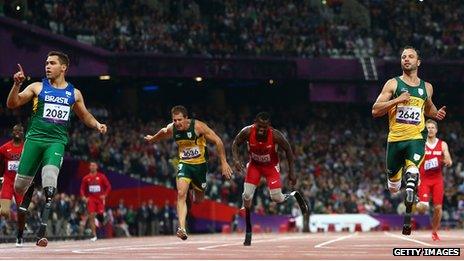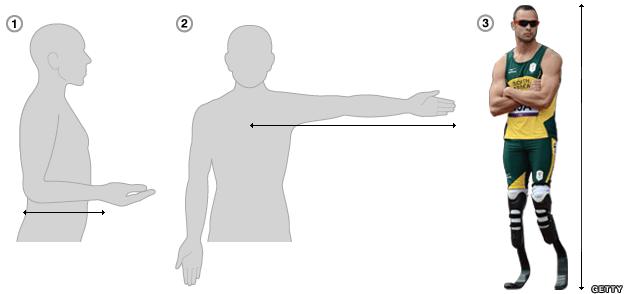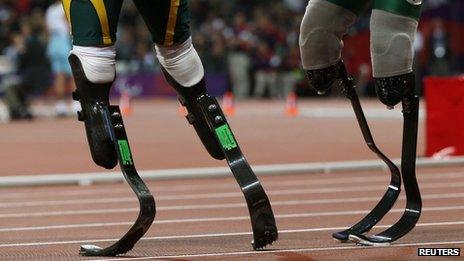Pistorius Paralympics gripe: How long can blades be?
- Published

Oscar Pistorius claimed that his rival was wearing blades that were too long. So how long are blades allowed to be?
He is known as the Blade Runner. But in the Paralympics 200m final Oscar Pistorius was overtaken by a faster man with blades.
Pistorius, who looked to be cruising to victory, spoke out after Brazilian Alan Oliveira surged past him in the last few seconds of the race to take gold.
Pistorius initially said he wanted the International Paralympic Committee (IPC) to address the issue of blade length, claiming Oliveira's knee heights are "four inches higher than they should be".
"Not taking away from Alan's performance, but these guys are a lot taller and you can't compete," Pistorius said.
The IPC disagrees, saying it was a fair race. All competitors had been checked before the race according to its classification handbook, the organisation says.
You can't have an unlimited length of blade. Their length is regulated by working out the notional height of an amputee athlete.
The IPC's 2011 Classification Handbook sets out a detailed formula, external. There is a mind-boggling array of anatomical terms, dimensions and calculations.

The maximum height of the athlete with blades on is essentially the mean average of the following calculations:
•1. The distance of the elbow bone "between point of the elbow (olecronon process) and the ulna styloid" is taken. This is then projected to a notional height using a chart.
•2. The "demi-span". This is the distance from the top of the chest, near the throat, to the middle finger when arms are stretched out - from "the middle of the sternal notch to the tip of the middle finger in the coronal plane". It is done with the athlete standing with their back against a wall, right shoulder "abducted" to 90° with the palm of the hand facing forward. Maximum standing height is then calculated from the following formulae. Females height in cm (1.35 x demi-span (cm)) +60.1. Males height in cm. = (1.40 x demi-span (cm)) +57.8.
Calculating the mean of the elbow bone height estimate and "demi-span" height estimate gives the final estimate of maximum standing height. The athlete with their competitive prostheses can be no higher than this figure plus 2.5%. (3)
Where an athlete has one amputated leg, they are allowed to have a prosthetic limb that is longer or shorter than the other side.
Despite the minute calculations of the classification handbook there is always room for debate. Pistorius may argue that the methodology is wrong or that the letter of the law was not imposed.
Pistorius, who holds the world record for the 200m, claimed that, although it is standard procedure for prosthetic blades to be measured before competition, "the guys rarely do the measuring in the call room".
He appears to be suggesting that different blades could be put on after the inspection.
The Brazilian denied the implied allegation, saying he had used the same blades for the last month.
Pistorius has built up an aura as the fastest man on prosthetic legs. He is also a poster boy for the Paralympic movement, winning legal battles to become the first athlete on blades to compete in the Olympic Games.

Pistorius claims that Oliveira's knee heights (right) are "four inches higher than they should be"
He is also the world record holder at 200m. So his silver medal was a shock.
For longtime Paralympic observer Tony Garrett there is a sense of deja vu. When Pistorius first burst onto the scene, the man to beat was American Marlon Shirley, a single amputee.
The South African beat Shirley in the 200m final in Athens in 2004 leading to questions from the defeated champion. "When Oscar took over from Marlon Shirley, Shirley said Oscar's legs seemed too big," recalls Garrett.
It seems like it has turned full circle now. For Garrett, it may simply be that Pistorius, far ahead of the field, thought the race was won. "I think Oscar got caught out a bit, that he was home and dry. If so, it was a costly mistake."
Meanwhile the debate over the nitty gritty of Paralympic classification is likely to continue.